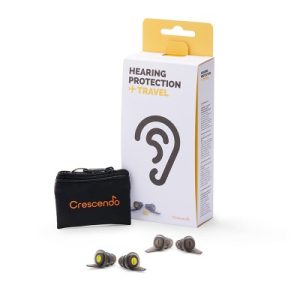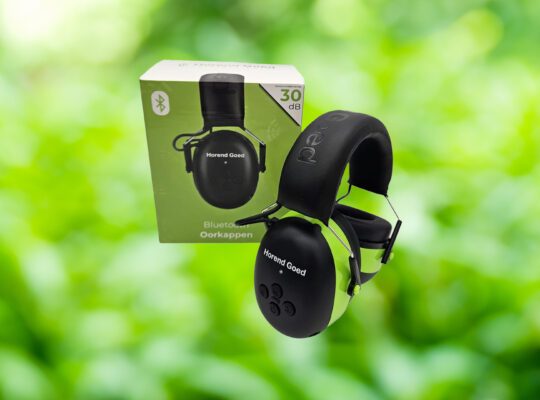At Horend Goed, we think it is important that you can travel comfortably and without worry, especially if you are taking a long flight to your winter sports destination. Flying often involves discomfort, especially due to the pressure changes in the cabin. This can lead to sore ears and fatigue, making the start of your vacation less enjoyable. Fortunately, pressure-regulating earplugs can make a big difference. In this blog, we explain how earplugs work for flying, why they are essential while traveling and how they specifically contribute to a worry-free winter sports vacation.
Why pressure on your ears while flying?
If you’ve ever flown, you’ve probably experienced the discomfort of pressure on your ears, especially during takeoff and landing. This is due to the rapid changes in air pressure in the cabin. Normally, the Eustachian tube, a small canal that connects the middle ear to the pharynx, helps regulate pressure in the ear. However, when air pressure changes rapidly, this canal may have trouble adjusting, leading to a feeling of pressure, congestion or even pain in the ears.
For some people this is a mild irritation, but for others it can be quite painful, especially if you are sensitive to pressure changes or if you suffer from colds or sinus problems, for example.
How do pressure-regulating earplugs work?
Pressure-regulating earplugs, like most hearing protection designed for air travel, help control pressure differences in the ears. These earplugs contain small filters that cause airflow to the middle ear to be slower. This slows the effect of sudden pressure changes and gives your ears more time to adjust, reducing the unpleasant feeling of pressure on your eardrums.
This means you’ll have less of the typical problems that can occur during a flight, such as sore ears, temporary deafness or a plopping sensation. So earplugs for flying are not only comfortable, but they can also help protect your hearing from long-term damage caused by sudden changes in pressure.
Why are earplugs for flying essential for winter sports?
When you go on winter sports, the adventure often begins with a flight to a destination at high altitude. These altitude changes cause pressure changes not only on the plane, but also in the mountains themselves. Winter sports destinations are often located at high altitudes, where air pressure is much lower than at sea level. These pressure changes can again affect your ears, especially while taking ski elevators or cable cars.
Earplugs for flying can also provide relief in these situations. They help your ears adjust to the pressure changes in the mountains, just as they do during flight. By wearing earplugs while flying and in the mountains, you can avoid discomfort and enjoy your vacation carefree.
What makes flying to winter sports destinations different?
Winter sports trips have some unique characteristics that make them different from regular air travel. First, winter sports destinations are often located at high altitudes, so air pressure changes are more pronounced while flying and in the mountains. This means that your ears are exposed to pressure differences not only during the flight, but also when you are in the mountains.
Moreover, the cold and dry air in the mountains can put extra strain on the sensitive skin of the ears and the ear canal. This makes it all the more important to use earplugs that protect your ears not only from pressure differences, but also from high winds and ambient noise.
Additional benefits of earplugs during winter sports
- Protection from loud noises
Ski areas are often noisy, especially around busy slopes and in après-ski areas. The noise from ski elevators, skis on the snow and busy crowds can be quite intense. Fly earplugs, which also have noise-reducing properties, can help reduce this noise, allowing you to concentrate better on your winter sports activities. - Wind Protection
While skiing or snowboarding, you are exposed to cold wind, which can affect your body temperature through your ears. This can even lead to ear pain or cold-related complaints. By wearing earplugs, you not only protect your ears from pressure, but also from the wind, keeping you warmer and more comfortable. - Better night’s sleep
Winter sports resorts are known for their lively après-ski, but not everyone loves it, especially when you’re trying to rest after a long day on the slopes. Soundproof earplugs can help you shut out unwanted noise so you can get a good night’s sleep and be back on the slopes fresh the next day. - Reusable and durable
Many pressure-regulating earplugs are reusable, making them a durable choice for frequent travelers and winter sports enthusiasts. You can use them again and again, not only during your flight, but also at other times during your vacation.
What should you consider when choosing earplugs for flying?
There are many different types of earplugs on the market, and it is important to know what to look for when choosing the right ones for your winter sports trip.
- Pressure regulating ability
Make sure the earplugs you choose are specifically designed to regulate air pressure while flying. These earplugs have special filters that gradually reduce pressure and prevent you from experiencing sore ears. - Comfortable fit
Because you often wear earplugs for long periods of time, it is important that they are comfortable. Choose earplugs that are soft and flexible so that they adjust well to the shape of your ear without irritating it. - Reusability
Some earplugs are designed for single use, while others are reusable. If you plan to use the earplugs more often, such as during multiple winter sports vacations, choose a reusable option that you can easily clean.
Tips for using earplugs during your flight
- Place earplugs well before takeoff
For best results, it is important to put your earplugs in before the plane takes off. This allows your ears to immediately adjust to the pressure differences. - Leave them in during the descent
Most people experience the greatest pressure on their ears during the descent of the plane. Be sure to leave the earplugs in until the plane has landed safely and the door is open so that your ears have time to adjust to the normal air pressure. - Use them in the mountains
Remember that pressure changes in the mountains can also have an effect on your ears. Wear earplugs when using cable cars or ski elevators to protect your ears from pressure changes.
Earplugs for flying at Horend Goed
In our webshop you will find earplugs for different applications, including music, sleep and so also pressure-regulating earplugs for flying. Ordered on weekdays before 15:00 = same day shipping!
Summary
Earplugs for flying are essential for anyone who wants to travel comfortably, especially during a winter sports vacation. Pressure changes on the plane and at high altitudes can cause discomfort, but with the right pressure-regulating earplugs, you can avoid this. Moreover, these earplugs offer additional benefits, such as protection from loud noises and wind, and help you protect your ears during your adventures in the mountains.
Whether you are a frequent traveler or preparing for your annual ski vacation, it is always a good idea to bring earplugs for flying. At Horend Goed, we have a wide range of earplugs suitable for different situations. Make sure you are well prepared for your next winter sports trip and enjoy a comfortable and pain-free flight!











